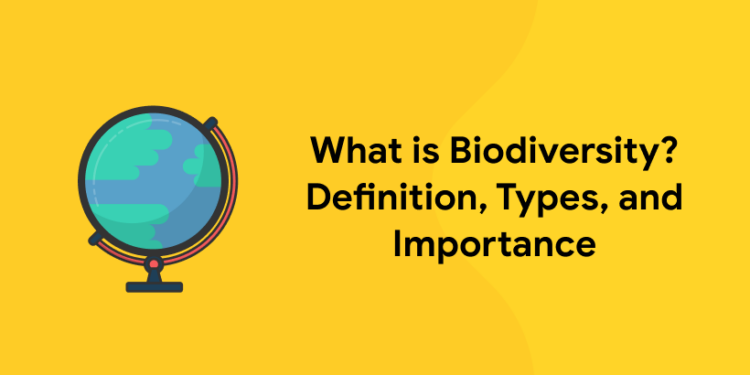Table of Contents
We live in a planet where abundance of plants, organisms, ocean, mountains, animals, birds, rivers, etc. All these things give life to the earth. This is one of the major and tremendous peculiarity of the planet compared to other planets. Earth is the only planet which is having life on it. The scientists are in constant search for other planet which has life on it. The earth’s Biodiversity has been subjected to different studies including the environment scientists. Are you confused with the term biodiversity? Even though it seems to be a generic term which includes all the living organisms and eco system there are different types, levels, and has got immense importance for the future life on the earth. Through this blog let us try to have a comprehensive study on the biodiversity by its definition, types, and importance.
Biodiversity – Definition and Types
The term biodiversity was first coined by Walter G. Rosen in the year of 1986. Biodiversity as a comprehensive topic gained several deep studies so far. The study and discussions on the National forum of Biodiversity was in 1986 was the first one to appear for and precedes all the study that has done thereafter. So many news and studies are being conducted in this subject on a day-to-day basis. So many competitive exams as well as subject exams usually poke their interest into these areas while they draft questions. So, the basic question here appears, what is meant by Biodiversity?
Biodiversity is an umbrella term which includes all the organisms eco system and species. there may be different definition according to different scientists. Don’t stick on to the definition as such but get a conceptual clarity. There are different types of Biodiversity as follows:
- Genetic Biodiversity
- Species Biodiversity
- Ecological Biodiversity
Click Here to Know More About General Awareness Relating to Biodiversity and its Importance
Genetic Biodiversity
There are various classification or levels in a biosphere as organism, species, population, ecosystem etc. In a single species may show a wide range of diversity in its genetic level over its distribution. This genetic level diversity shown by the species can eb said as the genetic biodiversity. India has 50,000 genetically different strains of rice and 1000 varieties of mango even though it comes under the same species called rice or mango.
Click Here to Enroll Entri App for Getting Updated General Awareness for your Exam Preparation
Species Biodiversity
A biodiversity not only includes a species genetics difference, there are different species too. The species differences and their population difference amount to the other level or stage of biodiversity. The term wild animals include not only lion, but also elephant, tiger, bear etc a lot of species. This kinds of species in different area and different level amounts to species biodiversity.
Click Here to Know More About General Awareness Relating to Biodiversity and its Importance
Ecological Biodiversity
There are different types of eco system included in a biodiversity. A biodiversity includes the diversity in eco system such as rain forest, deserts, ponds, lake, ocean, tropical forests etc. All these kinds ecosystem gives more diversity to the biodiversity which is attributed as other classification in the biodiversity called ecological biodiversity.
Reasons for the Loss of Biodiversity
1: Who was the first woman President of India?
The biodiversity of the earth is under constant degradation. The biodiversity of the earth is decreased and is destructed by various reasons. The major reasons for the loss of biodiversity includes:
- Habitat loss and fragmentation
- Human overexploitation
- Alien species invasion
- Coextinction
Click Here to Enroll Entri App for Getting Updated General Awareness for your Exam Preparation
Habitat Loss and Fragmentation
A species live altogether in a habitat. Each and every species needs a habitat for their living. The habitat loss and fragmentation amount to the loss of biodiversity. For example, the tropical rain forest which is a large habitat, had 14% of earth surface but it has now only a 6% of earth surface. The amazon rainforest which is called the lungs of the earth, is being cut for cultivation destructs a large amount of habitat. Some of the species needs a large amount of habitat. Mammals and birds need a large amount of habitat. When large amount of habitat is fragmented due to the human activities, it will affect these kinds of species.
Click Here to Enroll Entri App for Getting Updated General Awareness for your Exam Preparation
Human Over Exploitation
This is the major reason of the loss of biodiversity in earth. This is an umbrella term which can include all the exploitative activities of human being on natural resources. This leads to the destruction of biodiversity. Deforestation, mining, lake levelling, waste depositing, oil trenching, ocean exploitation whatsoever, even the unhealthy tourism also affects the biodiversity.
Click Here to Know More About General Awareness Relating to Biodiversity and its Importance
Alien species invasion
This can be another reason for the loss of biodiversity. This reason can be same time natural and also manmade. Some species may cross the habitat and enter into other habitat as alien results in the extinction of other species. The extinction of cichlid species of fish in the Lake Victoria due to the introduction of the Nile perch is an example for the alien species invasion. Some of the Bioresearch results in the formation of some special species which can be alien species to other habitats.
Click Here to Enroll Entri App for Getting Updated General Awareness for your Exam Preparation
Co extinction
The species in an ecosystem interact each other. The classic example for the same is the food chain. No species can exist independently. They constantly interact with other species or with the environment. If an extinction of a species takes place it may result into the extinction of another species. It’s called the co extinction. The phenomenon of coextinction can cause a loss to the biodiversity.
Free UPSKILLING Courses!
Take your first step toward mastering in-demand skills, acing interviews, and securing top-tier jobs with Entri's free upskilling courses.
Start Learning!Protection of the Biodiversity
Based on the theoretical explanations regarding the biodiversity it is not at all debate matter to the need of conserving or protecting the biodiversity. The protection of the biodiversity all around the world has taken in two dimensions:
- In situ conservation
- Ex situ conservation
In situ conservation
It is not at all possible to conserve all the biological wealth amidst the constant development where the world undergoes. The eminent conservationists put forward an idea of maximum conservation or priority should be given to certain regions. These certain regions with high level of species richness and endemism (a particular species is observed in that particular area and nowhere else) are termed as biodiversity hotspots. Initially 25 biodiversity hotspots were there, but now it’s been 34. Among this Western Ghats and Sri Lanka, Indo Burma and Himalayas cover exceptional biodiversity in India. The entire hotspots in the world account only for 2% of earth’s land area.
In India biodiversity rich areas are legally protected as biosphere reserves, National Parks and Wild life Sanctuaries. In India there are 14 wild life sanctuaries, 90 national parks, 448 wild life sanctuaries. Apart from the legal protection the Indian traditions protects the biodiversity area as sacred groves. Such sacred groves are found in Khasi and Jaintia Hills in Meghalaya, Aravalli Hills of Rajasthan, Western Ghat regions of Karnataka and Maharashtra and the Sarguja, Chanda and Bastar areas of Madhya Pradesh.
Click Here to Know More About General Awareness Relating to Biodiversity and its Importance
Ex situ conservation
The in-situ conservation was dealing about conserving the biodiversity in its natural habitat. Ex situ conservation deal with conserving the endangered species taken from their natural habitat and placing it in zoological parks, botanical gardens and wild life safari parks. Many of the extinct species in the natural habitats are conserved in many of the zoological parks in India. Thus, zoos are not only meant for tourism purposes but also for conservation of biodiversity.
Conclusion
The need and importance of the biodiversity and its conservation can be understood from the above blog. Apart from the point of view of examination this content should give you a moral suasion that none of your activities affect the biodiversity and ecosystem of our earth. Whatever be the profession we join, our small gesture of avoiding the activities that could do danger to the environment or biodiversity, will result in a great change to the earth. If you have cleared a lot of examination using this content and do practice activities that endanger the biodiversity, the blog is of no use. Even if you could not clear the exam, but you changed the attitude towards the biodiversity, the blog can be successful. So, Keep studying, Keep winning!












